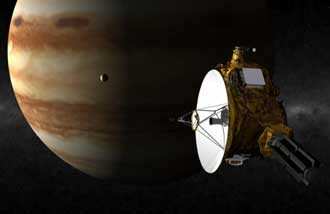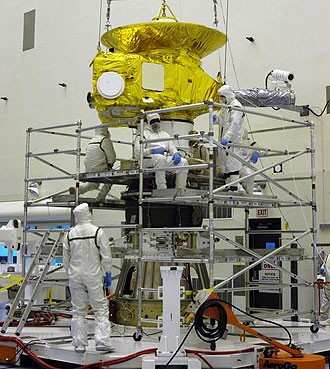Spacecraft Will Commit "Grand Theft Pluto"... And No
One Will Be Able To Catch It
By the time you read this, NASA's New Horizons probe will be
swinging by Jupiter, on its way to a rendezvous with the
almost-planet Pluto. The space agency says New Horizons will take
advantage of its first interplanetary encounter -- gathering
photos, data, and an extra 9000 miles per hour, courtesy of the
largest planet in our solar system.

New Horizons is already the fastest spacecraft ever to leave
Earth, but it needs even more speed to catch Pluto, which is
receding from the sun. Winter is coming to Pluto, and researchers
want New Horizons to arrive before Pluto's thin atmosphere freezes
and falls to the ground. (As NASA puts it, it's so much easier to
study an atmosphere when it's up in the air.)
So New Horizons is going to steal a little energy from
Jupiter.
"It's called a gravity assist maneuver," says Dr. Robert
Farquhar, formerly the New Horizons mission director at the Johns
Hopkins University Applied Physics Laboratory. "New Horizons will
dip into the gravity well of Jupiter and 'slingshot out' with more
velocity than it had when it went in."
Such a slingshot maneuver is a zero-sum game; in order for New
Horizons to speed up, Jupiter must slow down. But Farquahar says no
one will notice, as the change in Jupiter's orbit around the Sun
due to the flyby is fantastically small -- like "taking a single
drop out of the ocean," he notes.
This insignificant loss for Jupiter amounts to a big boost for
New Horizons. The piano-sized spacecraft will gain enough energy to
exceed 52,000 mph -- fast enough to reach New York from Tokyo in
less than eight minutes. New Horizons will reach the Pluto system
in July 2015 -- five years earlier than it would be able to
accomplish without the Jupiter boost.
Long before space travel was possible, Farquhar said,
astronomers saw the potential of using gravity to fuel space
travel. "We've known about this since at least the 19th century,"
he said.
Jupiter is not the only helping hand in the solar system.
Earth's gravity has donated its share of energy to ten different
space vehicles, beginning in 1990. The first was Giotto, a European
Space Agency mission to study Halley's Comet. Giotto launched in
1985, passed Halley's Comet in 1986, and in 1990 returned to
Earth's orbit, where it picked up a gravity-assist boost and a
redirection toward another comet, Grigg-Skjellerup, in 1992.

The most-recent spacecraft to fly by Earth was MESSENGER, NASA's
Mercury-bound spacecraft. Short for "MErcury Surface, Space
ENvironment, GEochemistry, and Ranging," MESSENGER launched on
August 3, 2004 and swung past Earth almost one year later in 2005.
Along the way, it picked up an added boost, a redirection, and
hundreds of stunning images of Earth.
Like MESSENGER, New Horizons will make the most of its flyby
time. Through June, it will make more than 700 observations. This
includes scans of Jupiter's turbulent, stormy atmosphere; a
detailed survey of its ring system; and a detailed study of
Jupiter's largest moons.
Later, after an eight-year cruise from Jupiter, New Horizons
will conduct a five-month-long study of Pluto and its moons.
 Aero-News: Quote of the Day (04.28.25)
Aero-News: Quote of the Day (04.28.25) ANN's Daily Aero-Term (04.28.25): Decision Altitude (DA)
ANN's Daily Aero-Term (04.28.25): Decision Altitude (DA) ANN's Daily Aero-Linx (04.28.25)
ANN's Daily Aero-Linx (04.28.25) Airborne-Flight Training 04.24.25: GA Refocused, Seminole/Epic, WestJet v TFWP
Airborne-Flight Training 04.24.25: GA Refocused, Seminole/Epic, WestJet v TFWP Aero-News: Quote of the Day (04.29.25)
Aero-News: Quote of the Day (04.29.25)




